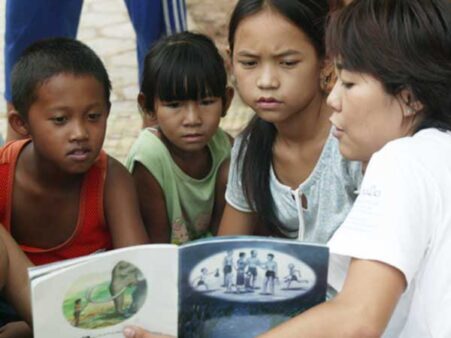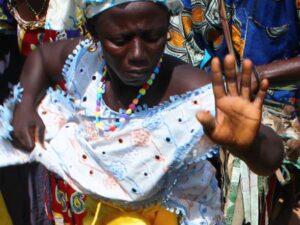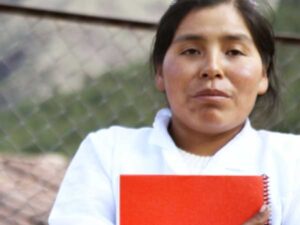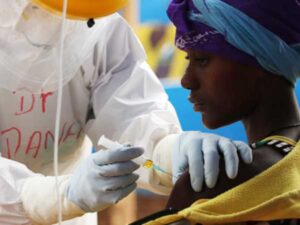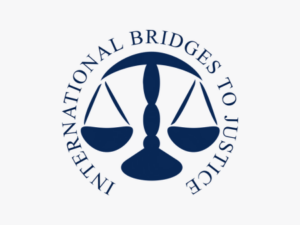Friends-International is a social enterprise that works to provide children, youth and their families a way to make a sustainable living, be free from abuse, and give back to their communities. They use a social business model where they operate businesses so that youth can receive real-world vocational training to help them obtain employment, while also generating funding to sustain the programs.
Sébastien Marot of Friends-International spoke with Ruth Terry on July 18, 2023. Click here to read the full conversation.
Ruth Terry: Could you start by telling me your name and your organization, and a little bit about the background of the problem that your organization addresses?
Sébastien Marot: My name is Sébastien Marot and the organization is Friends-International. Friends-International works with marginalized children, youth and their families, which includes street kids, kids out of school, out of work, prison, drug users, migrants, victims of different types of abuse. All the kids that have been in the system and abused by the system. Our job is to support them to become what we call functional, productive citizens of their country. Functional means they know how to function, productive means they’re part of the development and citizens means that they are active members of the society.
In order to achieve this, we run a series of projects that we call saving lives and building futures. Saving lives provides direct protection services in the slums, in the prisons, and everywhere to ensure that they remain safe. And then building futures is all about getting them back into society, which, for little ones, is back into school and staying in school for as long as possible. It’s also about access to employment and staying employed, and then rebuilding families so families are able to care for their children.
That’s in general, but as we moved in our work, we identified three main systemic issues that we are facing and that we’re addressing. The first one is the quality of the NGOs’ work in general. There are a lot of NGOs around and the quality is not always there. There are a few reasons for that. It’s either because they started with a good idea but they have not evolved and therefore the solutions that they offered 10 years ago are not relevant to the situation today, and then it falls flat. You have issues of the misidentification of the issue and then therefore, the wrong solution. A lot of organizations do that. For example, in most countries of the world, people see kids left to themselves and therefore they open orphanages to put all these kids in, assuming that they’re orphans or that the families are unwilling, unable to care for them, which is not the case. But it creates a wrong analysis of the situation, therefore the wrong answer to this problem and it can be very harmful. You have bad organizations, badly structured, badly built, badly trained. You have people who come with the wrong agenda. For example, when the agenda is not social, it’s religious. So there are many factors that make it very complicated and then the quality is just not there.
The second issue that we identified is, I like to say that you throw a stone in Cambodia and you hit an NGO, most certainly an NGO for kids. And that’s not only Cambodia, it’s true in a lot of countries in the world. The problem then is competition because you have a competition between these NGOs for resources. In terms of human resources, they steal each other’s staff. And you have local NGOs losing their staff to the international NGOs, losing their staff to the UN and others. That’s a major issue, especially if you’re at the bottom of this chain because you constantly have to train and rebuild your teams and that’s a real headache. You have competition for resources in terms of funding, you have competition for resources even in terms of organizations fighting for the same kids in the same areas. So you have overlap and it’s just a waste of time, energy, and money.
The third issue that we identified is that a lot of people want to do good, most people want to do good, but they don’t know how to do it. I know because that’s how I started. I didn’t know what I was doing and I learned by doing. There’s a lot of very positive energy, but when you don’t know what to do, often two things happen. Either you say, “Okay, I’m going to do something,” but because you don’t know what you’re doing, you’re doing everything wrong and you could harm people in the process, or harm yourself. You have cases, for example, of very nice tourists who bring kids into their hotel rooms to take showers and that’s ridiculous. It’s dangerous. Or you give money to the kids, all these things are really harmful. They are dangerous. It comes from a good place, but it’s dangerous. The other thing that happens is, “Well, I don’t know what to do, therefore I’m not going to do anything.” People turn a blind eye, think it’s not their responsibility, it’s the government’s, it’s the NGO’s, so they don’t do anything. That’s also bad.
Those are the three issues. And in order to respond to these three issues, we have created three responses based on what I told you before. Response number one, the issue being the quality, we build our own projects and we try through our projects to build innovation, trying to be really at the forefront of quality, building new models, et cetera. That’s what our projects across Cambodia, Laos, Thailand, Indonesia and Myanmar are doing. We tried different models. For example, we’re among the first trying to do business as a social work, social businesses since ’96. Things like this, trying new models constantly and trying to stay on top of the new issues that are coming, and finding solutions constantly. Just being aware that everything changes, we need to change with or even precede the change and be ready for it.
Then for the second issue, which is this coordination issue, we created what’s called the 3PC, the Partnership Program for the Protection of Children. It’s a global alliance of over 60 NGOs, mostly across Southeast Asia but also now in the Middle East, in Africa, and a few in Central America. We do capacity building, we do coordination, we do co-funding, and we do advocacy together. Basically, we’re working together to build a bigger, stronger child protection system across a region, an area, a country, or even more globally. Because, for example, on the issues of migration, we have to work on multiple country levels to build that protection system for migrant children.
To address the third one, the issue of the general public, we created the Child Safe Movement, which is a movement involving all the key actors in society to protect children. That includes the tourists, various types of companies, and the private sector. For us it is mainly the tourism industry because of their very important role in the countries where we operate, but we also work with the schools, especially private schools, to create systems that are child protective. We created an entire advocacy and training program for these different types of partners so we can train them and work together to protect children. That’s the network, the system approach that we have.
Ruth Terry: So, at each level, you’re providing some direct services directly to children and groups. They are the direct beneficiaries. Then there’s also –
Sébastien Marot: NGOs.
Ruth Terry: The NGOs that you’re working with through the partnership. And then also education training, resource or knowledge building with tourists and people who come into contact with children?
Sébastien Marot: Exactly. Our target groups are the children, youth and their families, NGOs, governments, and then the general public and the private sector. There are different levels of intervention because everyone has a role to play in the protection of children, but they’re more and more diffused. It starts from the center. Direct intervention to the concentric circle.
Ruth Terry: Would you say that’s what makes your approach distinctive? Because I’ve heard of NGOs doing one thing here or an intersection thing here, but I’m not sure that I’ve heard of such a coordinated effort like that.
Sébastien Marot: I would say that’s one of the things that make us very different from many NGOs. There’s a few things. There’s a holistic approach in terms of service provision. Many organizations take care of one type of issue or one type of population, but that will not solve the problem. You need to be holistic because people are not one-sided, they’re multifaceted and you need to address a lot of issues at once. So that’s one. The second is the fact that we are very much doing global, systemic work, and I haven’t seen many doing this. The other is the fact that we mix business and social by building social enterprises. I would say that is also distinctive. Training restaurants, training beauty salons, different types of businesses that we run that are social businesses because they have a social objective but they run as businesses. That’s how we build our own financial sustainability and we reduce donor dependency, which is very, very important. Especially now after COVID where donor funding is getting more difficult.
Ruth Terry: Can you tell me a little bit more about that? My next question was can you share an example that illustrates the impact of your work, and I’d love to hear more about some of these businesses.
Sébastien Marot: We have three types of businesses. We have our three big programs, as I said, the Friends Alliance, the 3PC, and the Child Safe Movement. For each program, we have developed a business model that then funds part of the operations. For the Friends Alliance, our programs, it’s all about the social businesses, training businesses. We do a lot of vocational training to help young people get jobs. For us, the best training possible is an applied training, not a theoretical one because they don’t have that kind of education, they don’t have that kind of mental framework, they haven’t been trained for that. Also, because they’re often not literate enough, learning in a classroom makes no sense. With learning by doing, they become highly employable. So you run restaurants and in the restaurant you serve a client, you drop your glass of water on the knee of the customer, you get immediate feedback. You learn very fast and very well, which also means that you are highly employable when you come out. So we run restaurants, we run beauty salons, we run garages, we run shops, et cetera. And each of them teaches skills, soft skills and hard skills, to the young people so that when they come out of the training, they are highly employable.
The money goes back into the functioning of the training. If you’re good in business, you make some money, you cover some of the costs. If you’re very good in business, you cover all the costs of the training. If you’re super good in business, you make a profit and then that profit can then be re-injected in other social work. For Friends-International, we reached 44% sustainability before COVID. That means 44% of our full budget was coming from our own resources. And in some areas, like Phnom Penh, we were at 66% sustainability. So it depended on the maturity of these businesses and the different locations of course, but the model was moving well. COVID has killed it all because we had to close everything. We’re slowly reopening now and we’re aiming at the same level.
Ruth Terry: So all the revenue from the businesses gets cycled back into the training, and then after that, with that training, people are able to go to other businesses and find work.
Sébastien Marot: Exactly. That’s the model for Friends Alliance. The model for the Child Safe Alliance is consultancy. We have developed a consultancy business using the entire network of NGOs, and we are hired by organizations, like UNICEF to conduct trainings. We are training all the partner NGOs of UNICEF in Indonesia and are training NGOs and the government in Thailand. And we’re being paid for this, which is always very good. That gives some sustainability and it is restarting extremely strongly after COVID. The last one is for the Child Safe Movement where we are now starting a new business called the Child Safe Experiences, which sells experiential adventures to tourists and companies. Tourists often want a real adventure when they travel. They go to orphanages, they have direct contact with people without really being checked, and that is extremely dangerous. So we are offering those kinds of experiences in a safe environment while also teaching them about Child Safe’s work and what they can do. So it’s both training and an experience that they pay for. Companies are paying for it, individuals are paying for it, and that’s a big money maker. We think that it will eventually cover the entire running cost of the Child Safe Movement.
Ruth Terry: That’s fantastic. I have a nonprofit background and I also do travel writing, and so I totally get what you’re saying about the damage that, even well-intentioned, tourists can do. Especially going from the global north to global south, there’s a whole dynamic there. What other insights or teachable lessons can be taken from your work that others could use? What advice would you give to other people who want to replicate some aspect of what you do or transfer that way of thinking about a project?
Sébastien Marot: This question I saw and I found it very difficult because it is very pretentious to think that you can give lessons to people. Plus no one wants lessons, everyone wants to do it themselves. Anyway, that said, there are a few things that I think are important. One is, don’t reinvent the wheel because often you come and you think you’re the only one. You’re not. You need to really look at what’s happening and what’s already in place. It’s better to reinforce what exists than just saying, “Well I do it also.” Then you just add another layer to something that’s already very complex. Especially if you’re coming from outside into another country, a foreigner, I’m taking me as an example, the danger is to constantly say, “Okay, I know better.” And just add another service that is not necessarily needed because it is already in place. Then you undermine the work that’s been done for many years by others.
Even though the laws are really not there, putting the business component into your organization and always thinking how to put a business aspect to it, it doesn’t hurt your social mandate, it can only reinforce it if you do it well. That’s the balance that is sometimes difficult between the business and the social, but the business component can really reinforce your social side if done well. So do not hesitate. Many people are very wary about this, but increasingly because of the way donors evolve, it is something that I think is needed. The laws are not always there, like I said, and that can create problems, but there are ways to navigate that.
Ruth Terry: I think the business piece is so important and I especially appreciate the way you’re doing it in a way that’s training. It’s not limited to a very narrow skillset or a very narrow product. That’s something that I don’t think I’ve seen as much of as I would like in my exposure to development or nonprofits and other things. So I think that’s an interesting part.
Sébastien Marot: I think what you said is really important. Don’t stay narrow in anything you do because the issue that you want to address is connected to so many other issues. It’s never standalone. And if you don’t look at what’s happening around and that impacts your own issue, you’re not going anywhere. It’s the same for training. If you offer one training, not everyone wants to be a cook, so you have to have a range. People are complex. Everyone’s different, so our work is extremely complex because of that. But that’s why it’s social. The holistic approach is something that is also very important. Even if you do something very precise, you still need to think about what’s happening around it and how it impacts what you do and how you can impact it. I think that is very important.
Ruth Terry: What are some of the metrics that you use to measure success in your organization?
Sébastien Marot: You have the traditional ones, data collection is massive, obviously. How many people do we reach? We reach about 80,000 people globally a year – children, youth and family members. During COVID, we reached 26,000 people in emergency. So these are numbers that we have. We know how many people we train, how many Child Safe agents we have, that’s something else that’s absolutely brilliant, I should have mentioned. It’s something I really like in our model is Child Safe agents. Child Safe agents are people in the communities that we train to protect children. They’re basically volunteers working for us to protect children when we’re not there because they live in the communities 24 hours. We’re not in the community 24 hours. In some communities, we cannot go so they are there and they bring the problems to us. And they can work with us to solve the problems.
That’s 13,000 children protected just by agents. All these things are really important to create a system. All these numbers are gathered, so that’s data obviously. Then we have case studies, stories. It’s very powerful to know what happened to individual people because that’s not something you measure. It’s to see how they evolve, what happened and how complex situations are. I think that’s very, very good. Then we work a lot in creating policies with governments, helping shape policies that are designed and that are put in place, all this is also very important because it impacts how countries and the services are being reinforced at a system level, at the government levels, which impacts the entire country. This is really important.
We built all the child protection systems in the Thai government shelters. We created the policy for drugs in Cambodia, the policy for migration, many things like this that are really important. How is it measured? Well, it’s measured because the policy is voted for, it’s implemented, it’s in the system, then it’s not us anymore because it belongs to the government and it belongs to everyone. But it’s there. So how is it measured? It’s measured by existing. The most difficult thing that we’re facing in measurements is behavior change, because a lot of our work is behavior change. How do you measure the change in behavior of people? It’s tricky and it’s very expensive. It’s very complicated. That’s where we have a problem. And it’s really something you need to look at on a longer scale, a longer time, but it is very expensive. You need funding.
One angle that’s really important, it’s something that is in our pipeline but not yet built, is as part of the Child Safe Movement we want to also train and educate donors. And part of the consultancy we do is to try to evolve the way donors operate and think. There are a lot of organizations doing this, so it’s a little tricky. But in the field there’s no one. There’s a lot of people in Switzerland and France doing this to their donors, but they’re disconnected. So what we would like to think about is how to show donors the reality of the work and how they need to evolve their thinking to be supportive versus coming in with their own agendas, top down, their requirements that don’t fit or are unrealistic. But that’s a difficult one.
Ruth Terry: Is there anything that you have tried and that just totally didn’t work and that is something that others could learn from?
Sébastien Marot: The trick is to try to fail, to revise, to rebuild and to move on from that failure. So I’m built on failure. I’m only failure and mistakes. So I don’t even know how to start answering that question because everything has come from that learning process.
Ruth Terry: I love that answer.
Sébastien Marot: It is true. My successes are because I stubbornly continued working on my mistakes and my failures. The other thing is, your failure is a few things. It’s either because you misunderstood the issue. So when I first started, for example, I had 17 kids come to the center the first night. One week later there was only one left because I misunderstood what they were asking me. They said, “We want to learn.” I started a school. They were teenagers. What they meant is, “We want a job. We want a job, we want to learn how to…” So I started vocational training. [The school was a] big mistake. I wasted time and money, but changed rapidly when I understood what the problem was, and built the vocational training. That’s one. It’s misunderstanding the issue, misunderstanding the expectations, and then being able to understand and then adapt.
The other thing is, there are factors that are outside of your own control. Things are changing, so again, when I started vocational training, one of the first things I did was weaving because there was a big market for locally made mats that people sat on, ate on, slept on. The mats are used widely for everything. It’s very useful. And they were handmade and so we started weaving those and, bad news. Thailand has come in with mats that are industrially made plastic, cheaper, easier to clean, et cetera, et cetera. It destroyed the market. I had to stop. That’s an external factor that forces you to fail, but reinvent yourself, right? Because well, that market is there. I have to build another market. You start the training and you ask, “How long is it going to be good for and is it really something?” I was asked to do training on some very specific skills, and I’m like, “I’m going to overkill the market. I’m going to train 10 people and the market will be saturated. Or it’s going to be replaced really quickly because I know that in other countries it’s already industrialized, it’s going to come here really cheap, there’s no future for this. Let’s not do that.” And I had a difficult time explaining this strategy to my teams because it seemed at that time a very good idea. I knew that two years down the road it was dead.
Ruth Terry: I think that’s so important and I really respect your market and business acumen that way to be able to think, “Hey, we can’t just think about what tourists are going to want to buy or what we can sell.” Aside from funding, what are the challenges that you’ve faced or maybe challenges that you’re currently facing that you haven’t been able to overcome yet.
Sébastien Marot: So funding is… I won’t mention it because you said don’t mention it, but I will mention it because it’s a real bummer. I’ll quickly say two things. One problem is the lack of flexibility of the donor. That’s very problematic. I saw this during COVID where they said, “No, we gave you money for this. You have to achieve that.” I’m like, “It’s COVID, everything has changed. You cannot do this anymore.” This lack of flexibility is really a big problem. The other problem is the change in strategies that donors constantly have. You don’t know where they’re going to go and how, and you have zero visibility. So planning and building something on the scale of what we do at Friends-International with this vision of a system, having donors that are not reliable is problematic. Running after donors is a lot of time spent, energy spent that I could use on other things.
The other problems are often, again, governments for different reasons. For example, we train people at the government level, but they change constantly because they move, so new people come in. You have to restart from zero, retrain, reexplain, and even if you have created the system within the government and it’s an official system, it’s not Friends-International coming in saying, “You should do it this way.” It’s part of the system. You still have to retrain everyone, convince them again and start over. It’s like Sisyphus. Ugh, your rock is running down again, then you start again. That’s really heavy. It’s part of the system that you work with. You know, but it’s heavy. The other issue is when politics come into play. In Myanmar, we had a coup, and it is really complicated. Their system is extremely tough. We tried to send $10,000, but it was blocked for over a year because they needed to do a background check over $10,000. So we’re sending $3,000 at a time. You can’t run a program like that.
You also have other NGOs that are in competition with you and it’s ridiculous, but it happens all the time. Especially international NGOs. We had organizations copy our Child Safe program. They did it for three years because they had three years of funding. They created a mess for three years and then left. Same for the network of NGOs. We’ve been running a fantastic network and others come in and say, “Ooh, that’s a great idea. We’ll do the same.” “It’s already there. It’s already operational, it’s embedded in the government. What are you thinking?” “Oh, we have more money than you.” Money doesn’t mean that you can do things. Often having a little less than you need makes you more creative and more efficient.
Western privilege embeds a lot of our issues. It gives us this right to come into a place and say, “Ooh, I know better and start my own organization.” When you already have some really good ones that should be supported to do the job themselves. The fact that you come in and you have the audacity to start an orphanage because you think that’s how kids should be taken care of, all this is deeply rooted in this imbalance and it’s really problematic.
Ruth Terry: Thinking about the system level change, how do you see your work evolving in the next five years or so?
Sébastien Marot: I think that some of the system programs like the Child Safe Movement, the Alliance, and within even our own programs, the Child Safe agents, these things are easily replicable and rapid, cheap to set up. This is the future where we are going. I’m also looking at the next phase for myself. I’m not getting any younger, and so what’s going to happen next? And for me, what’s really important is not that Friends-International survives, because that’s ridiculous, it’s that the work continues.
I’m always saying, if you want the best of the best, the best of the best is not going to take over your organization, they’re going to start their own. So I am now working a lot in mentoring young people to start their own initiatives. I find that really interesting. So the mentorship side, helping this network of NGOs build the local initiatives, or not local, that doesn’t matter. In our own programming, things that are more systemic and higher level and more global. Building a network of really exciting programs.
Ruth Terry: That’s fantastic. I feel like a lot of people don’t think in that way in terms of succession planning and kind of grooming the next generation.
Sébastien Marot: I avoid those discussions because they turn into, “Oh, who’s going to take my spot?” That’s so egocentric. “My program that I started needs to live on.” It’s like, no. Why? That’s why we end up with those big international NGOs that are just dinosaurs and should disappear because they would make space for many others to do exciting things.
Ruth Terry: I think that’s such an important takeaway. Thank you so much for taking the time to talk with me and share your insights.
Click here to read the full conversation.
Ruth Terry is an award-winning social impact writer based in Istanbul, Turkey, with bylines in Al Jazeera, BBC Travel, National Geographic, NBC Think, The New York Times, The Washington Post, Time, and more. Writing across topics and genres, she has covered everything from race to roller skating through a lens of social justice and equity.
* This interview has been edited and condensed.
Find other social innovation organizations working with youths.

